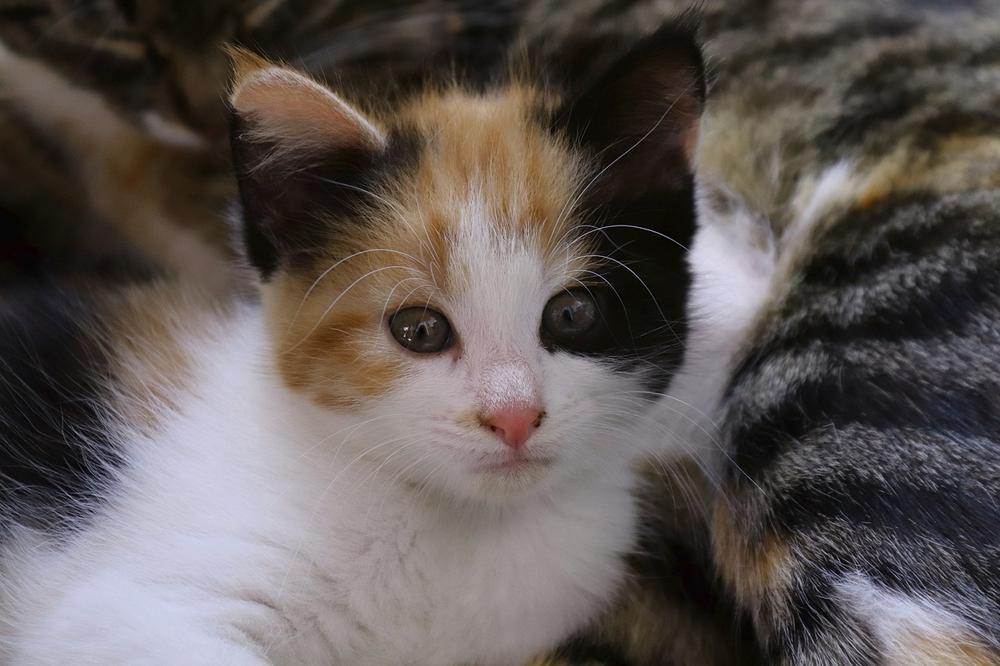How to Determine the Sex of a Cat? (Super Useful Guide)

Are you desperate to know if your furry friend is a boy or a girl?
I feel you, buddy.
It's like trying to solve a mystery, and the frustration can drive you insane. 😫
But fear not!
In this I Care for Cats guide, I'll reveal the secrets to determining the sex of your enigmatic feline.
Get ready to unravel the truth NOW or forever wonder.
Genitalia Inspection: Not a Walk in the Park
Determining the sex of newborn kittens ain't no walk in the park, my friend.
You gotta have perfect timing, buckets of patience, and know how to handle them little furballs right.

But don't fret, I'm here to help you out.
Now, when it comes to inspecting a kitten's private parts, keep these handy tips in mind:
- Wait until those cute little fellas are around 2 to 3 weeks old. This is when both mama cat and the kittens are ready for this sort of thing.
- There are two main ways to go about it: take a good look at their nether regions or gently feel below the anus to find those tiny testes in male kittens.
- Male kitties have a roundish pecker that's set a bit apart from the butthole, and if you run your fingers carefully, you might just stumble upon some small balls hanging out there too.
- Now, girl kitties are a tad different. You'll notice their booty hole and lady bits are closer together, with a vertical slit, also called a vulva.
- Don't forget to pay attention to the shape and position of the anus and privates. Sometimes these details can give you even more clues.
Getting the gender right is super important, especially if you wanna take proper care of these cuties or find 'em good homes.
Although it becomes clearer when they're about six to eight weeks old, figuring out the sex of newborn kittens takes a sharp eye and a gentle touch.
So, go ahead, take your sweet time, and handle those precious fluffballs with tender loving care! 😺
Main points I'll expand upon further down this article:
- Visual cues like coat color and behavior provide hints but are not always accurate.
- Male cats are typically larger and more muscular than females.
- Female cats may have visually noticeable nipples, especially if they have given birth.
- Observing behavior can help determine a cat's sex, but it's not reliable for kittens.
- Seek veterinary advice or resources from International Cat Care if unsure.
- Common mistakes include assuming all tortoiseshell and calico cats are female.
- Approximately 70% of ginger cats are male.
- Both male and female kittens can make excellent pets.
- Spaying or neutering cats before puberty minimizes sex-related differences.
- Neutering is recommended to prevent unwanted litters and find a good vet.
Visual Cues Work for Adult Cats
Determining the sex of adult cats can be helped by some visual cues:
- Check out their body shape: Male cats usually have a bigger, more muscular build than females.
- Notice their coat color: Certain colors and physical traits are often linked to one gender or another, but it's not always reliable.
- Look for hidden genitals: Male cats keep their private parts hidden, while female cats might have visible nipples, especially if they've had babies.
- Pay attention to behavior: How they behave can also give you hints about their gender. Males may act dominant, while females tend to show nurturing tendencies.
But remember, these cues aren't foolproof.
It's best to consult a vet to get the most accurate determination of your cat's sex.
But wait, there's more to understanding cat behavior than just determining their sex.
In fact, certain behaviors can change depending on the stage of life a cat is in.
Let's dive deeper into this fascinating topic…
Behavioral Differences Also Work
Observing behavioral changes in female cats
When female cats become mature and go into heat, you'll notice they start acting differently.
They might meow more, appear restless, and roll around.
So, if you have a female cat and she starts displaying these behaviors, it's a good indication that she's in heat.
Now, pay attention!
Understanding the behavior of adult cats is important, but relying solely on behavior to determine their gender isn't reliable, particularly for adult cats.
The importance of spaying and neutering
Female cats usually reach sexual maturity around 4 to 5 months old. It's best to consider getting them spayed or neutered as soon as possible.
This not only prevents unintended pregnancies but also helps prevent certain health issues and reduces the chance of your cat roaming and getting into fights.
But here's the great news:

Once your cat undergoes spaying or neutering, there won't be significant differences in behavior between male and female cats.
So no matter whether you have a male or female cat, their behavior will likely be similar.
Tips for dealing with female cats in heat
During heat, female cats may occasionally have some vaginal discharge.
If your female cat experiences this, ensure she feels comfortable and create a calm environment to minimize her stress levels.
It's also crucial to follow advice on preventing stress and conflicts among all your cats, regardless of their gender.
Stress and conflicts can lead to various behavior problems, so make sure your home provides a safe and harmonious environment for all your furry friends.
And if you're curious about an interesting aspect of cat behavior that goes beyond the typical male or female traits, I invite you to explore my guide on Can Cats Be Gay.
You might find it enlightening and thought-provoking.
Don't miss out on the fascinating insights this article provides regarding the diversity of feline behaviors.
Discover a different perspective and satisfy your inquisitiveness.
Difficult Cases: Intersex Cats
Understanding intersexuality in cats
When it comes to sex and gender, things can be a bit complicated for cats too.
Some kitties aren't strictly male or female.
They might have characteristics that don't fit the norm.
Consult a veterinarian for accurate diagnosis
If you're unsure about your cat's sex or suspect they may be intersex, it's best to consult a vet.

They're experts who can thoroughly examine your cat and give you a proper diagnosis.
Determining a cat's sex can be tricky, especially with kittens or neutered males.
Vets can guide you through the process and make sure you know the right information about your cat's sex.
Seek expert advice for difficult cases
Taking care of intersex cats can present challenges. If you're stuck or facing difficulties, reach out to experts like vets or organizations specializing in cat health and behavior. They'll give you tips and guidance on handling these situations and ensuring your intersex cat's well-being.
When dealing with tough cases, seeking professional advice is crucial.
That way, you can make informed decisions and provide the best possible care for your furry friend.
Common Mistakes in Sex Determination
When it comes to sex determination in cats, there are some common mistakes that people make.
Let's dive right into it:
- It is a mistake to assume that all tortoiseshell and calico cats are female. While the majority of them are indeed female, there are rare instances where some can be male due to genetic anomalies.
- Another mistake is assuming that approximately 70% of ginger cats are male. This is not accurate as the sex distribution among ginger cats can vary.
- People sometimes believe that tabby cats have an equal chance of being male or female, which is not true. Tabby cats can be either male or female, just like any other cat.
- It's important to note that both male and female kittens can make excellent pets. Gender should not be the sole determining factor when choosing a cat to adopt or keep as a pet.
- The spaying or neutering of kittens before reaching puberty can help minimize sex-related differences that may arise in adulthood.
Understanding the sex-related characteristics of cats requires careful observation and knowledge.
Understanding Cat Reproduction
Kittens can get knocked up real young, as early as four months old, so you must keep an eye on them.
Cats like to get busy during breeding season and have multiple estrus cycles throughout. That's a whole lot of potential for accidents, which is why getting your cat spayed or neutered is damn crucial.
Don't try this at home: find yourself a good vet who knows how to perform the procedure.
Unless you're purposely trying to breed those furballs, then that's a different story. And if you see your kitty strutting around with a swollen belly hangin' low, well, congratulations, you've got a momma-to-be on your hands.
And that wraps up today's article.
Before you take off, can I ask you something? Did my blog post end up being useful for you? If it was, I would be so grateful if you could share it with your loved ones. Feel free to click on any of the social media sharing icons for a quick share. Thank you so much!
Talk soon,
-Sarah Davis